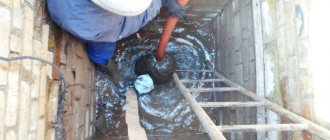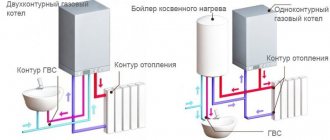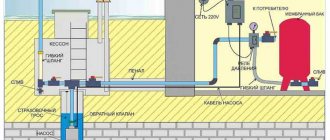Cleaning a wellbore from sand with a bailer
If you have at least a small plot of land at your disposal, and provided that the underground reserves of life-giving moisture are not too far from the surface, you can easily solve the issue of supplying your home with high-quality, and mind you, free water. And such a tool as a bailer can help you not only drill a hole, but also subsequently carry out its periodic cleaning.
What is this tool, what are its designs, and what is their functionality? What does a hand-made bailer ? Based on drawings and photographs , we will provide detailed information - and we really hope that it will be useful to you.
Downhole bailer - what is it, device, principle of operation
A bailer is a special device for cleaning the bottom of a borehole channel from soil and silt deposits. In essence, this is a 1-2-meter section of pipe, the lower part of which has a sharp point - in the form of teeth or a chamfer. A reverse-acting valve mechanism is located inside it. Thanks to this device, dirt, soil, silt and other insoluble particles enter and remain inside until the pipe is lifted to the top and cleaned.
The device operates on the principle of impact interaction. Therefore, the main parameter showing the effectiveness of the bailer is mass. The greater its value, the more productive its use will be, but also the more difficult it is to maintain. The mechanism of its action is carried out according to the following algorithm:
- The pipe section is suspended on a steel cable above the well using a lifting gate on a tripod.
- Next, the bailer is lowered to the bottom of the shaft.
- Then it rises a few meters, and the mount completely relaxes.
- The sharp edge of a steel pipe in a state of free fall crashes into the bottom sediments with force.
To collect bottom sediments, a bailer is inserted into the well and released into free fall Source budshop.com.ua
- As a result of this interaction, the valve mechanism opens and the pipe cavity is filled with dirt.
- The procedure is repeated several more times until the entire internal space is filled with silt.
- After this, the pipe rises to the top and is cleaned.
- If necessary, the operation is repeated until bottom sediments stop flowing into the pipe.
- Finally, the borehole channel is flushed using a pump.
Note! At the stage of attaching the bailer, it is important to correctly select the thickness and degree of rigidity of the cable. It must provide a sufficient margin of safety so that the pipe does not come off, since it will be impossible to remove it from the well after this. On the other hand, it should not be excessively rigid and thick so that it can provide sufficient acceleration to the pipe in free fall.
Maintenance, operating tips
The following signs will indicate that it is time to seal:
- For some reason the well was not used for several months.
- The pump is missing air.
- Water contains impurities.
- After several minutes of running the tap, the water stream visually becomes thinner.
When starting to clean a working well, and this can happen every 3-4 months, be sure to make a visual assessment of its internal surface. The work may be complicated or made impossible by significant deformation of the shaft walls, loss of their integrity, or severe siltation.
Then the condition of the working equipment is checked: wear and strength of the cable, free (without jamming) operation of movable joints, reliability of fasteners.
A tripod installed above the well with a block onto which the cable is placed will help make the work easier. The result is strictly vertical operation of the device, easy lifting through the block, especially with an additional winch used. To ensure that a device torn off during operation does not create a serious problem and does not stop the process for an indefinite time, it is advisable to weld a pair of hooks to the pipe. They will come in handy for quickly removing it from the well in case of force majeure.
All work with the device ends with thorough cleaning of the internal cavity from soil. The square window at the top of the pipe will help make this faster and easier. For clayey or dense viscous soils, such a window is made along the length of the entire pipe. It is advisable to store a clean and dried bailer in a dry utility room until the next use.
On moist, sandy, loose, soft soil, you can independently drill a well or make a diagnostic puncture using a device. If the soil structure does not meet the specified characteristics, the work is entrusted to specialists using professional equipment.
Varieties
Based on the above mechanism of action, it turns out that such a bailer can be used not only for cleaning, but also for punching or drilling out a well. Depending on the purpose, the design of the device itself changes.
A bailer is a piece of pipe with a pointed working edge and an internal valve Source saucyintruder.org
There are 3 main modifications of it, differing primarily in the type of valve:
- Petalaceae.
The device is equipped with this version of the valve mechanism, which is based on a movable metal flat petal. The element is fixed in the lower part inside the pipe on a pulley, repeats the geometric shape of the cavity section and works according to the following principle:
- When the device is immersed to the bottom of the well and comes into contact with the ground, the petal rotates.
- A passage opens and deposits begin to fill the cavity.
- When the pipe is lifted, the dirt filling the cavity begins to put pressure on the back side of the plate, it rotates back and the valve closes.
- On the surface, the device is turned over and emptied of dirt.
- The procedure is repeated until the bottom sediments are completely cleared.
This option is simple and inexpensive to manufacture. Can be used for both cleaning and drilling. The only drawback is the short service life. It is cured by the fact that part of the pipe with the valve is made removable with a thread, and if it breaks, it is simply screwed off and a new one is installed in its place.
After lifting from the well, the bailer must be cleaned each time Source ytimg.com
See also: Catalog of companies that specialize in engineering systems (heating, water supply, sewerage and others) and related work
- Ball.
In this modification, the well cleaning bailer is locked with a ball. Operation is ensured by the following feature of the device and operating principle of the valve:
- From below, in the area of the working part, the movement of the ball inside the cavity is limited by an inserted and secured ring or funnel.
- In the normal state, the ball lies on the ring and closes the passage.
- When immersed, bottom sediments move the ball upward and begin to fill the cavity.
- To prevent the ball from coming out through the upper cut of the pipe, a limiting pin is installed inside - for example a bolt.
- When the pipe rises upward, the masses of dirt in the pipe put pressure on the ball, it lowers, rests against the ring and the exit closes.
- The raised bailer is cleaned and reused until the channel is completely clean.
The advantage of this option is high efficiency, load resistance and durability. However, it is somewhat more difficult to manufacture than the previous version. It can be used both for cleaning an old well and for creating a new well.
A special washer is installed into the working edge of the pipe for the operation of the ball valve Source ytimg.com
- For drilling.
In order to drill a vertical channel in the ground, you will need a bailer slightly modified with the following working components:
- The cutting part that is in direct contact with the ground should have the shape of pointed teeth that are slightly spread out to the sides.
- Another piece of pipe is inserted into the cavity, reaching the middle of the device and fixedly attached to it and equipped with a thread.
- Subsequently, as the drilling depth increases, the length of the structure increases with additional segments through a threaded connection.
To make the device rotate more easily and loosen the soil, the pipes are equipped with through holes along the entire length at a short distance from each other. Rotation is carried out through a piece of reinforcement inserted into them. Borehole channels of shallow depth are created by punching - by analogy with the cleaning technique; deeper ones, and also in the case of passing through dense rocks, are drilled by rotation.
Drilling with a bailer requires special training and the use of additional equipment Source ytimg.com
On a note! The use of bailers for drilling the soil is justified only for borehole channels of small depth - no more than 10 meters. Since the method requires significant physical effort, a lot of time and is characterized by low productivity. Otherwise, you will have to mechanize the installation, and this will lead to greater costs than using specialized drilling equipment, and the available depth will only double.
Features of cleaning a well using a bailer
If at one point you discover that your water channel is clogged with sand or silt, then, naturally, it must be broken through. The best equipment for this is a bailer. Of course, this process requires significant force, but it is the first in terms of efficiency and safety. In addition, you do not have to waste electricity or rent expensive equipment.
In principle, the cleaning process is carried out in the same way as drilling a well. Naturally, before starting work, it is necessary to find out the cause of the blockage. If you simply clean the channel, after a while it may become clogged again. Naturally, it is necessary to eliminate the causes of the problems.
Cleaning a well with a bailer has one advantage: how well the channel worked before work began does not matter. For the presented procedure, it is better to take a long piece of pipe (about 1 m). Next, all accumulated dirt, silt and sand are removed from the well by impact.
Thanks to this design, you can bring back to life a completely clogged well that could not be cleared with other devices. To completely clean the channel, you can use a submersible pump. With this device you can pump water until you get crystal clear liquid. Now you see that a do-it-yourself well bailer can be made and used very easily.
To prevent the well from becoming contaminated again, you can periodically repeat the presented procedure. Please note that we should not forget about those measures that help prevent channel clogging. Now you know how to make a bailer with your own hands, as well as where and how it is used. Good luck!
Contrary to all stereotypes: a girl with a rare genetic disorder conquers the fashion world. This girl's name is Melanie Gaydos, and she burst into the fashion world quickly, shocking, inspiring and destroying stupid stereotypes.
These 10 little things a man always notices in a woman Do you think your man doesn’t understand anything about female psychology? This is wrong. Not a single little thing can be hidden from the gaze of a partner who loves you. And here are 10 things.
Why are some babies born with an "angel's kiss"? Angels, as we all know, are kind to people and their health. If your child has the so-called angel's kiss, then you are out of luck.
7 Body Parts You Shouldn't Touch with Your Hands Think of your body as a temple: you can use it, but there are some sacred places that you shouldn't touch with your hands. Research showing.
Unforgivable Movie Mistakes You Probably Never Noticed There are probably very few people who don't enjoy watching movies. However, even in the best cinema there are mistakes that the viewer can notice.
13 signs that you have the best husband Husbands are truly great people. What a pity that good spouses don't grow on trees. If your significant other does these 13 things, then you can s.
Specifics of drilling in various soils
Drilling water wells with a bailer is not too different from the cleaning technology, with the exception of sandy soils and so-called quicksand - here it is necessary to carry out the procedure inside the casing, for example, of the corresponding diameter of a PVC pipe. In denser rocks this need does not arise.
To drill in unstable soil, it is necessary to use PVC casing pipes Source burovik.ru
In general, when creating a borehole channel in each type of soil there is its own specificity:
- Quicksand . The use of casing is mandatory, since without it the walls of the created channel will quickly collapse. To do this, a shallow pit is created into which the casing pipe is immediately placed. Then a bailer is inserted into it and cyclic deepening and cleaning of soil is performed. As you move deeper, the casing is continuously built up using segments.
- Dry sand . The procedure is carried out in a similar way, but with the exception that water is constantly supplied into the created channel to make it easier and faster to extract the soil mass.
Along the way of laying a well, various aquifers and soil types may be encountered Source buroplast.ru
- Clay . The operation is performed without casing. Soft rocks can be drilled with one pipe - without a valve mechanism. The soil will simply accumulate in the pipe and then be removed as it is lifted. In clayey rocks of high viscosity, it becomes necessary to preliminary break up the layer with a chisel, and then remove the already loosened mass with a bailer. If the clay is dry, it can be slightly moistened until the drill reaches the aquifer.
- Crushed stone and gravel . When layers of crushed stone and gravel appear along the excavation path, the casing pipe is slightly raised to avoid compaction of the soil mass, and the speed and pressure on the drilling mechanism is lightened. They also slightly increase the water supply. If necessary, a chisel is first used, after which the crushed mass is taken out with a bailer.
Recommendation! To avoid significant siltation and shutdown of the well, it is necessary to clean its channel every 1-2 years. The frequency of the procedure directly depends on the operating mode and the frequency of water intake. Therefore, every responsible owner of an autonomous water source will need a reliable, high-quality bailer.
Principle of operation
A bailer is used for drilling wells in loose or loose rock (sand, loam). The device is used to increase the volume of water and remove sand and silt.
The work is carried out according to one principle - the device is thrown down.
Accelerating under the influence of gravity, the projectile hits the rock, which, penetrating inside, opens the valve.
Having passed inside, the soil releases the valve, and it closes, preventing the rock from spilling back out.
With one blow, 200-300 grams of rock are collected, so the bailer is raised up 30-50 centimeters and thrown again.
These steps are repeated until the device is completely filled with soil. The filled shell is lifted to the surface, turned over and the rock is removed.
IMPORTANT! This method is called shock-rope. To construct and clean the well, this operation is repeated many times.
Clearance may take 3 to 8 days. It will take several weeks to drill a well in this way (read how to install water supply in a private house in this article)
To construct and clean the well, this operation is repeated many times. Clearance may take 3 to 8 days. It will take several weeks to drill a well in this way (read how to install water supply in a private house in this article).
To facilitate the work, install a tripod with a block system. This setup makes the job much easier.
If a bailer does not pick up soil well, then it is usually too light. The projectile is weighted by filling the top of the pipe with concrete or by attaching a weight to the bottom.
Manufacturing methods
There are the following 2 main ways to make a bailer for cleaning or drilling a well - these are:
- Petal.
The manufacturing procedure is reduced to the following algorithm:
- A pipe section of 10-15 cm is selected - with such a diameter that it fits into the bailer as tightly as possible.
- A circle is cut from sheet metal to exactly match the outer diameter of the insert.
- Next, the element is fixed to the insert using spring loops.
- Then the pipe section is carefully inserted into the bailer and secured through the pre-drilled holes with a swamp.
- The position of the insert is such that the valve opens only inward - to take in the soil mass.
Kinds
By type of valves there can be:
- Ball.
- Flat folding.
Ball type is a very convenient and common option.
The ball moves freely inside the pipe when it is squeezed out by silt, but under the influence of gravity, it clogs the hole again. More suitable for small diameter pipes.
If there is simply no suitable ball, a flat part is made from any available materials (corresponding to the inner diameter of the pipe), which is hinged to one of the inner edges. Water resistance opens the flat valve. The hinges must be corrosion resistant. In addition, to ensure that the valve closes well, you can make a bumper pin inside the pipe. It will limit the plate opening to 70-80°
The ball model must have an internal limiter. If this is not done, the ball will “flush” too high and most of the collected sludge will flow back out.
Video description
Video instructions for making a bailer:
A wire loop, pin or bolt is attached to the opposite part of the bailer to secure the cable.
- Ball.
To make a bailer of this modification, you will need:
- Select a metal ball of suitable diameter - for example, if a 90 mm pipe is used, then it should be about 55-65 mm.
- The lower edge of the bailer is sharpened - like a chamfer or in the form of sharp teeth.
- Next, a washer of a suitable size is inserted into the lower part to fit under the ball. In its normal state, the ball should tightly cover its hole.
- At a height of 3-4 ball diameters from the washer, a limiter, for example a bolt, crashes into the pipe wall.
- To attach the cable, a through hole is drilled in the upper part of the pipe.
Note! Before starting work on cleaning the borehole channel, you need to make sure that there are no obvious defects on its walls. Otherwise, the bailer may jam when lowering.
Gelonding scheme with pump
In case of large deposits of silt or sanding of an aquifer mine, they resort to gelling technology with a pump. To do this, the upper part of the body is welded and an outlet is mounted to it.
After installing the fitting with the hose, a pump is connected, designed for pumping liquids with a high content of mechanical impurities. This method allows you to pump out bottom sediments without constantly cleaning the instrument. The work of the bailer itself boils down to the need to loosen the soil and move it into the chamber.
Briefly about the main thing
The bailer is a piece of steel pipe with a pointed lower edge and a valve mechanism inside. When it is lowered freely into the well, the valve opens and releases soil masses inside, and then, when lifted, it closes and prevents their exit. This method is used to clean or drill a borehole channel.
Devices are divided into 3 main types:
- Ball.
- Petalaceae.
- Specially designed for drilling.
Each of them has its own pros, cons and operating features. Drilling with their help has its own specifics depending on the type of soil. You can make a bailer for cleaning a well yourself if you have experience in processing and assembling metal structures, but it is better to entrust this task to a specialist or buy a ready-made factory model.
Ratings 0
Composition of tool elements
The main components of the bailer device are the following elements:
A section of hollow steel, less often cast iron, pipe up to 3 meters long and with an internal diameter of ≤ 60 mm. Wall thickness ≥ 4 mm. The thicker and longer the pipe, the greater the mass of the dropped projectile and the efficiency of its use. But as the weight increases, the effort required to lift it from the casing shaft increases. Shut-off check valve to retain developed rock, silt particles and water in the pipe cavity. The following types differ according to their design features: ball. At a distance of 5 cm from the bottom of the pipe, a thick washer or conical plate with a hole in the middle with a cross-section slightly smaller than the size of the ball is firmly welded inside it.
It is important that the ball placed inside the glass tightly plugs the hole. The steel ball is approximately 25% smaller than the diameter of the tube shell
It is recommended to use a ball made from a large bearing; you can find a suitable one on the market or order production at a lathe; plate-type with a rotary hinge and a steel pin welded to the inside to limit opening to 800. Tightness is ensured using rubber strips; petal ones, consisting of two thin steel or polymer plates hinged inside the tube shell, so that the petals do not have the opportunity to fly up during a hydraulic shock; limiting stops are installed.
The principle of operation of any valve system is similar to the operation of curtains that allow dirt mixed with water to pass through only in one direction. The ball valve is the most reliable and durable in operation. An impact shoe made of a pipe, connected by a threaded connection to the main glass by screwing into it. To facilitate soil development, the shoes are equipped with a cutting edge or several sharp teeth. Thermal hardening of these parts is recommended, which will significantly extend the service life. When using a ball check valve, a limiter is required to prevent the ball from flying out of the cup. Some sources provide for the installation of a safety metal grill, which is not the best option. The time the ball falls after hitting such a high grate takes a certain time, during which the mixture that has penetrated into the glass will not allow the ball to close the inlet hole. A thick smooth steel rod welded inside the glass approximately 0.5 m from the bottom will work more efficiently. Steel lugs or a bracket firmly attached to the top of the tool. Metal cable or strong synthetic rope.
Plastic bottle valve
A suitable plate can be made using a plastic container.
- To do this, you need to cut an ellipse from its wall with sides of, for example, 90 and 70 mm. The smaller number must be equal to the internal diameter of the projectile.
- Then insert two wire rings - 6-8 mm - into the middle part of the oval.
- Next, drill a couple of parallel holes in the pipe.
- Well, then slightly bend the petal, carefully push it inside the body and secure it with a bolt with the appropriate double radius, passing it through the seats.
Quantity of material and cost
After you have determined the pitch of the sheathing for the corrugated sheeting, you should select the dimensions of the bars or boards for the base, if it is planned to be wooden.
Requirements for raw materials:
- Wooden elements must be durable and free of damage.
- The timber must be dry, treated with antiseptics and other substances that increase the service life of the support and prevent rotting and the development of microorganisms.
- The minimum permissible cross-section of a bar is 50x50 mm, for a board the height is from 20 mm. The choice of base will be determined by the corrugated sheet: sheet size, its design and weight. Accordingly, the more powerful the canvas, the larger the cross-section of the supports.
For metal lathing, special profiles are used.
To determine the required amount of material for the base, count the number of beams taking into account the selected pitch for a given type of profiled sheet.
The cost of a cubic meter of wooden board depends on the degree of its processing and cross-section parameters. You can use both edged and unedged. The price for 1 m 3 starts from 3500 rubles.
If the roof sheathing under corrugated sheeting is made of beams, it will cost more: from 4800-5000 rubles. for 1 m 3.
How to make a cutting edge
A shoe with a pointed edge cuts better into sticky and frozen soil, which greatly simplifies the work. And there are two options for its suitable form:
- Flat - you need to sand it on the outside and grind it inward on the other side, making it look like a cone. It is great if the steel is also hardened - this prevents breakage or dulling.
- Toothed - a “herringbone” is made, and each of its protrusions is processed in the same way as the entire edge in the previous case, only separately. To protect the contact surfaces, you can then apply paint or primer.
Useful recommendations from experts
If the depth of the water exceeds the length of the drill, then it can be extended by joining another pipe on top. They can be joined using a threaded coupling or a welding connection. When using small diameter pipes, bolts or cotter pins can be used. However, such a connection is not very reliable, and with a large rotational force, the bolt can be sheared and the rods will become disconnected. Getting the drill remaining in the well can be very problematic.
Before starting to design the device, it is recommended to draw up a drawing of the drill for the well. This will give you the opportunity to have a visual example of what should come out in the end. Attempting to create a drilling mechanism using the “scientific poke” method is more exciting for some home craftsmen, but takes too much time and effort.
An easier manual version of drilling a well is using a bailer bit. Raising and releasing the impact tool requires less force than rotating a buried drill. In addition, even one person can drill using the percussion method. True, this method is very long, and the work can drag on for several days.
If you cannot lift the auger drill out of the well yourself, you can make the task easier by building a device for the lever. For example, placing a barrel next to it and throwing a block over it. Tie one edge of the block to the drill, and apply physical force to the other edge.
Helpful2Not Helpful
If you don't have a welding machine
Let's look at how to make a bailer with your own hands and ensure reliable quality of connections when it is not possible to solder the elements together. To do this you should:
- take a suitable pipe;
- drill 2 holes in its upper part, thread a steel wire and fix it;
- make a petal valve from a plastic bottle (we will explain how below separately) and secure it to the shoe with a 6-8 mm bolt of the appropriate length.











